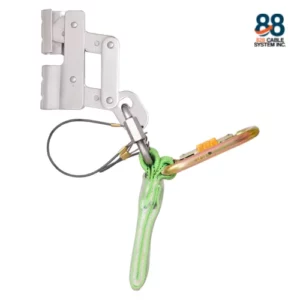In the bustling industrial landscape of the Philippines, ensuring the safety of workers, especially those working at heights, is paramount. Temporary lifeline systems play a critical role in providing the necessary fall protection during temporary work activities. These systems are designed to enhance workplace safety and comply with rigorous safety standards, making them a valuable asset in various industries. This blog delves into the key features and benefits of temporary lifeline systems and their significance for Philippine industries.
What Are Temporary Lifeline Systems?
Temporary lifeline systems are essential safety tools used to protect workers from falls when working at elevated areas. Unlike permanent systems, which are fixed and intended for long-term use, temporary lifelines are designed for short-term applications and can be easily installed and removed as needed.
Types of Temporary Lifelines:
Horizontal Lifelines: Installed horizontally across a work area, providing fall protection as workers move along the line.
Vertical Lifelines: Attached to a vertical structure, such as a scaffold, allowing workers to climb safely.
These systems differ from permanent lifelines in that they are often more flexible and portable, suited for temporary setups where permanent installations are impractical.
Key Features of Temporary Lifeline Systems
Portability and Flexibility: Temporary lifelines are designed to be easily installed and removed, making them ideal for projects where the work environment or location frequently changes. This adaptability ensures that safety measures are always in place, regardless of the project’s temporary nature.
Compliance with Safety Standards: Adhering to safety regulations, such as OSHA standards, is crucial. Temporary lifeline systems must meet these standards to ensure that workers are adequately protected. In the Philippines, compliance with these regulations is essential for maintaining a safe working environment and avoiding legal issues.
Durability and Reliability: Constructed from high-quality materials, temporary lifelines are built to withstand various environmental conditions. Regular inspections and maintenance are vital to ensure their continued effectiveness. Checking for wear and tear helps prevent accidents and ensures that the system remains reliable throughout its use.
Benefits of Using Temporary Lifeline Systems
Enhanced Worker Safety: The primary benefit of temporary lifeline systems is the protection they offer against falls. By providing a secure anchor point, these systems reduce the risk of serious injuries or fatalities, allowing workers to perform their tasks with increased confidence and safety.
Cost-Effectiveness: While permanent systems can be expensive, temporary lifelines offer a more cost-effective solution for short-term projects. They provide significant long-term savings by minimizing the risk of accidents, which can lead to costly medical expenses and work stoppages.
Flexibility for Various Applications: Temporary lifelines are versatile and can be customized to fit different work environments. Whether it’s for construction sites, bridge work, structural steel erection, or pipe rack installation, these systems can be tailored to meet specific job requirements, ensuring optimal safety for all types of temporary work.
Implementing Temporary Lifeline Systems in Philippine Industries
Choosing the Right System: Selecting the appropriate temporary lifeline system involves considering the specific needs of the job, including the work environment and the nature of the tasks. Consulting with experts, such as 828 Cable System, can help businesses choose the most suitable solution for their requirements.
Installation and Training: Proper installation is crucial for the effectiveness of temporary lifeline systems. Following installation best practices and providing adequate training for workers on how to use the systems correctly are essential steps in ensuring safety. Workers must be familiar with the proper use and maintenance of the systems to maximize their effectiveness.
Regular Inspections and Maintenance: Regular inspections are necessary to maintain the integrity of Temporary lifeline Solution in the Philippines Any signs of damage or wear should be addressed promptly to prevent accidents. Establishing a routine maintenance schedule helps ensure that the system remains in good working condition throughout its use.
Takeaway
Temporary lifeline systems are a vital component of workplace safety in industries across the Philippines. Their key features, such as portability, compliance, and durability, make them an ideal solution for short-term fall protection. By investing in these systems and ensuring proper installation and maintenance, businesses can enhance worker safety, reduce costs, and achieve compliance with safety standards. For expert advice and tailored solutions, contact companies like 828 Cable System to ensure your temporary lifeline systems meet your specific needs.











